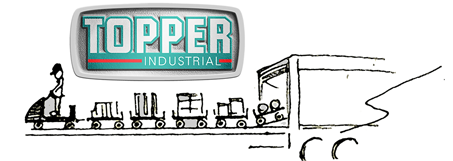Walking the plant floor or distribution center adds zero value. Value is only achieved at work locations, never between them. Poorly designed operations have pickers walking more than ten miles a day on the floor increasing errors, injuries, and declining productivity.
Fork truck free environments do not eliminate all the walking, but allows a dramatic and quantifiable reduction in the walking “commuting time” to collect and retrieve product. Inefficient designs make work difficult, less efficient, and is certainly not lean.
Mobile workstations brought to the work are perfect for kitting and assembly at the cellular level. By reducing the time spent walking from docks and picking areas for labels, purchase orders, checklists, and other documents, workers spend more time working, improving throughput. From a shipping dock to a printer at the other end of the building, there could be 3,000 steps.
The lean value proposition with a conveyor workstation ensures what is needed on a regular basis is available on a regular basis, either at-hand or just a few steps away. FMCG (Fast Moving Consumer Goods) 80/20 rule means those products used frequently are readily available. Most operations can start with this in good shape, but as processes and inventories shift, SKU proliferation creates a poor workflow.
Locating supplies and people who use them in the same area makes sense, but that space is often in demand for inventory, work cells, storage areas, and other important considerations. Enter lean and 5S principles.
Rather than having packing employees run for tape, filler, or other materials, fork truck free environments brings needed materials to the worker. Topper Industrial flow racks are instrumental in mobile storage options and efficient replenishment. Inventory needed for an assembly process is a lean principle; orders move through straight lines. This does not eliminate rework, changes, or customization; these can roll the needed stock to the work-in-process as needed, reducing the need for work-in-process or pending orders to shift place in the line.
Mobile carton flow rack is an ideal way to provide instant, first-in, first-out, high-density storage that moves to points of value as needed, then moves on to the next station when ready to proceed.
The Valued of Reduced Walk-Time
Anytime manufacturers can reduce cycle time to improve balance with takt time and ultimately free up a person, there will be savings. Similarly, reducing machine setup time and reduce lot sizes and inventory carrying cost, it generates savings.
So, say one step takes one second….
Shop rate Dollars/Hour X 100 cents/dollar
————————————————-
60 minutes/hour X 60 seconds/minute
For example:
$36/hour X 100 cents/dollar = 3,600 cents/hour
———————————————————
3,600 seconds/hour = 3,600 sec/hour
A good informal way to express the cost of excessive travel is identified from a Spaghetti Diagram, or using the “1 second = 1 cent rule.” If the ‘shop rate’ in the company is $36, then each second of walking costs the company one cent! This is because $36 = 3,600 cents and there are 3,600 seconds in an hour (60 minutes x 60 seconds). Depending on the shop rate at a particular factory, one can figure this out for themselves by using the formula listed above. For professional service workers, where an hour can be worth $180 or more, every second spent walking is like throwing away a nickel!

Now multiply that by the number of people walking the plant floor and the cost of wasteful walking becomes the easy rationale and ROI (Return on Investment) for a fork truck free initiative.
*** Contributions made by Chris Mosby, LSSMBB. Chris Mosby is the Lean Manager for Topper Industrial. Mosby has been a Lean/Six Sigma trainer for more than 20 years in multi-faceted, fast paced manufacturing environments. His experience includes management assignments in Quality, Production, Logistics, Healthcare, and Maintenance/Engineering.

Information submitted by Jillian Burrow, Marketing Manager for Topper Industrial


No Comments Yet!
You can be first to comment this post!